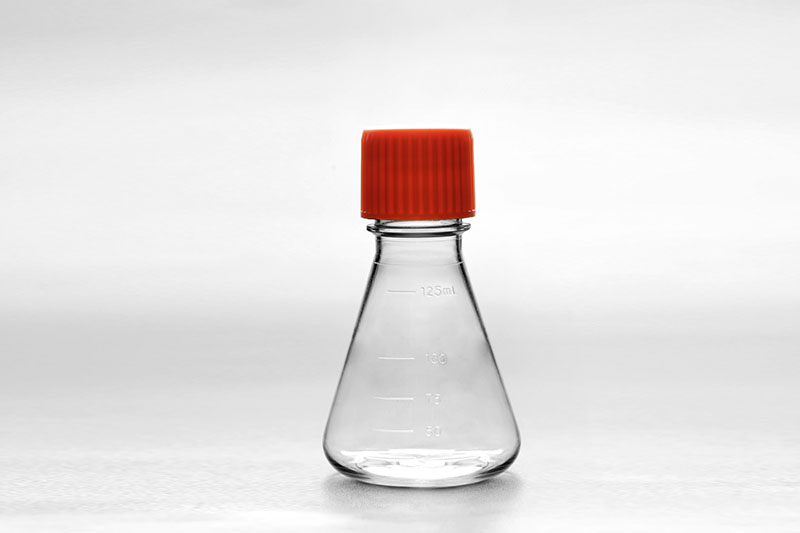Medžiagos ir metodai
3.1. Shake Flask Cultivations
MDCK.SUS2 suspensijos ląstelių išankstinės kultūros buvo auginamos Šaltinis iš: (125 ml polikarbonatinės Erlenmejerio kolbos, Nr. 431143, Corning®, Niujorkas, NY, JAV) su 50 ml darbiniu tūriu (wv) , Multitron Pro inkubatoriuje (Infors HT, Bottmingenas, Šveicarija) 37 °C temperatūroje ir 5% CO2 atmosferoje, kratymo dažniu 180 aps./min. Ląstelės buvo pasėtos kas 3–4 dienas, sėjimo tankiu 0,5–0,8 × 106 ląstelės/mL. prilipusiose MDCK ląstelėse (ECACC Nr. 84121903). Sėklinio viruso titras buvo 1,1 × 109 TCID50/mL. Ląstelės buvo kultivuojamos chemiškai apibrėžtoje, be baltymų ir gyvūnų komponentų neturinčioje terpėje Smif8 (Smif8 PGD 2×, papildyta 5 mM glutamino ir 8 mM piruvatas), specialiai sukurtas suspensinėms MDCK ląstelėms auginti [95]. Augimo ir infekcijos eksperimentai modelio patvirtinimui buvo atlikti naudojant 500 ml kratymo kolbas (#4113-0500, Nalgene™, Thermo Scientific, Waltham, MA, JAV), kai pradinis auginimo tūris yra 200 ml esant 150 aps./min. Buvo atlikti du kultivavimo būdai: viena imitacinė infekcija (1 kultivavimas), kai ląstelės augo apie 200 valandų, ir viena infekcija (2 kultivavimas), kai ląstelės buvo užkrėstos IAV praėjus maždaug 49 valandoms po inokuliacijos. Norint pasiekti sinchronišką ląstelių populiacijos infekciją, buvo naudojamas moi = 10. Dėl santykinai mažos ląstelių koncentracijos infekcijos metu (2, 1 × 106 ląstelės / ml) ir didelio naudojamo moi, nebuvo būtinas nei terpės pakeitimas, nei tripsino pridėjimas (virusui aktyvuoti). Abiejuose kultivavimuose prieš imant mėginius buvo įpiltas sterilus Milli-Q vanduo, siekiant kompensuoti vandens išgaravimą (1–2 ml per dieną), nes eksperimentas buvo atliktas nehidratuotame inkubatoriuje.
https:/ /www.mdpi.com/2218-1989/12/3/239/htm
Cells were cultivated in a chemically defined, protein-free and animal component-free medium, Smif8 (Smif8 PGD 2×, supplemented with 5 mM glutamine, and 8 mM pyruvate), specifically developed for the cultivation of suspension MDCK cells [95].
Growth and infection experiments for model validation were performed using 500 mL shaking flasks (#4113-0500, Nalgene™, Thermo Scientific, Waltham, MA, USA) with an initial cultivation volume of 200 mL at 150 rpm. Two cultivations were performed, one mock-infection (Cultivation 1), where cells grew for about 200 h, and one infection (Cultivation 2), where cells were infected with IAV at about 49 h post inoculation. To achieve a synchronous infection of the cell population, a moi = 10 was used. Due to the relatively low cell concentration at time of infection (2.1 × 106 cells/mL) and the high moi used, neither medium replacement nor trypsin addition (for virus activation) was necessary. In both cultivations, sterile Milli-Q water was added before sampling to compensate for water evaporation (1–2 mL/day) since the experiment was performed in a non-hydrated incubator.
Source from: https://www.mdpi.com/2218-1989/12/3/239/htm
The FAI climbed 5.9 percent year-on-year in the first 11 months of 2018, quickening from the 5.7-percent growth in Jan-Oct, the National Bureau of Statistics (NBS) said Friday in an online statement.
The key indicator of investment, dubbed a major growth driver, hit the bottom in August and has since started to rebound steadily.
In the face of emerging economic challenges home and abroad, China has stepped up efforts to stabilize investment, in particular rolling out measures to motivate private investors and channel funds into infrastructure.
Friday's data showed private investment, accounting for more than 60 percent of the total FAI, expanded by a brisk 8.7 percent.
NBS spokesperson Mao Shengyong said funds into weak economic links registered rapid increases as investment in environmental protection and agriculture jumped 42 percent and 12.5 percent respectively, much faster than the average.
In breakdown, investment in high-tech and equipment manufacturing remained vigorous with 16.1-percent and 11.6-percent increases respectively in the first 11 months. Infrastructure investment gained 3.7 percent, staying flat. Investment in property development rose 9.7 percent, also unchanged.
 English
English



















































